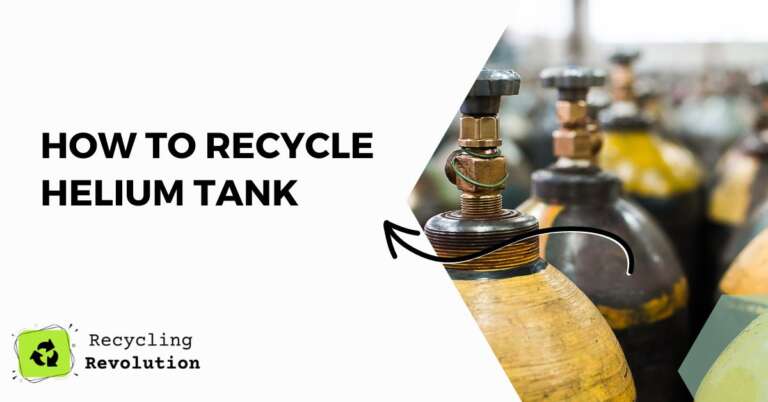There’s a certain magic in watching a helium balloon ascend to the heavens, but what happens to the helium tank when the fun is over? The after-party, unfortunately, isn’t as joyous for our environment.
It’s vital to recycle helium tanks, as they contain remnants of this precious, non-renewable resource. Helium, the second lightest element in the universe, is crucial in various sectors like healthcare, scientific research, and technology, making its preservation essential.
Benefits of Recycling for the Environment
Beyond helium conservation, recycling these tanks aids the environment by reducing landfill waste and preserving natural resources. Studies by the Environmental Protection Agency (EPA) suggest that recycling one ton of metal can save up to 1.5 tons of iron ore and reduce water pollution by 76%.
By recycling your helium tank, you’re not just saving helium but also contributing to a healthier planet.
| Component | Material | Recyclable? | Approximate Scrap Value (as of 2021) |
|---|---|---|---|
| Tank Body | Steel or Aluminum | Yes | Steel: $0.01 – $0.02 per pound, Aluminum: $0.20 – $0.35 per pound |
| Valve | Brass | Yes | $1.25 – $1.75 per pound |
Understanding Helium Tanks
Helium tanks, typically made of steel or aluminum, are high-pressure vessels that store helium gas. They come in various sizes, from small party-balloon tanks to large industrial tanks.
The two common types of helium tanks are disposable and refillable. Disposable helium tanks are lightweight, convenient, and perfect for occasional use, like parties. Refillable helium tanks, on the other hand, are durable and suited for regular or commercial use.
Discarding helium tanks improperly can cause significant harm to the environment. According to a report by the National Waste & Recycling Association, metal tanks can take up to 200 years to decompose.
They can also leak leftover helium, contributing to the depletion of this scarce resource.
Preparing the Helium Tank for Recycling
- Safety Precautions – Before you start, remember that safety comes first. Wearing protective gloves and eyewear is recommended, as residual helium could cause frostbite.
- Proper Handling and Storage of Empty Tanks – Empty tanks should be stored upright in a well-ventilated area, away from heat sources and flammable materials.
- Venting the Remaining Helium Safely – Ensure the tank is completely empty by attaching a balloon to the nozzle and letting the gas escape. This process might take a while, but it’s crucial for safe handling.
- Cleaning and Purging the Tank – Once emptied, the tank should be cleaned and purged of any residual gas. This involves opening the valve to allow any trapped helium to escape and cleaning the exterior with a damp cloth.
Researching Local Recycling Options
- Local Recycling Facilities and Centers – Most communities have recycling facilities that accept metal tanks. You can use resources like Earth911’s recycling directory to locate a facility near you.
- Contacting Local Waste Management Authorities – If you’re unsure about local recycling options, reach out to your local waste management authority. They can provide information about the proper disposal and recycling of helium tanks.
- Online Resources for Locating Recycling Options – Online platforms like RecyclerFinder and RecycleNation can help you find recycling options in your area.
Packaging and Transporting Helium Tanks
Appropriate Packaging Materials
Wrap the tank in bubble wrap or other cushioning material to prevent damage during transportation.
Securing the Tank for Transportation
Once cushioned, secure the tank in a sturdy box. Ensure the tank is snug and can’t move around to avoid any mishaps during transport.
Labeling and Marking the Package
Clearly mark the package as “Helium Tank for Recycling.” This will help the recycling center identify and handle the tank properly.
Proper Handling during Transport
Always handle the tank with care during transport. Avoid dropping or roughly handling the tank to prevent any potential accidents.
Recycling Process
Drop-off vs. Pick-up Options
Some recycling centers offer drop-off services, while others may provide a pick-up service. Check with your local facility to see what options are available to you.
Recycling Facility Requirements
Each recycling facility has its own set of rules and requirements. Make sure to adhere to these guidelines when preparing your helium tank for recycling.
Tank Preparation Guidelines for Recycling Centers
Generally, recycling centers require helium tanks to be empty, with the valve open to demonstrate it’s safe. However, you should always check the specific guidelines of your chosen recycling center.
Certification and Documentation for Recycling
Some facilities might require documentation, like a recycling certificate. Always ask the recycling center what documents, if any, are necessary.
Alternatives to Recycling
Reusing Helium Tanks for Other Purposes
If your helium tank is refillable, consider reusing it. You can refill the tank for future events or even use it as an air tank for inflating tires.
Donating Tanks to Organizations or Businesses
Some organizations or businesses might accept donated helium tanks. Reach out to local schools, scout troops, or party supply stores to see if they could use your tank.
Local Trade-in or Buyback Programs
Check if any local suppliers offer a trade-in or buyback program for your helium tank. This could be a great way to ensure your tank is reused and not wasted.
Repurposing Tanks for DIY Projects
Feeling creative? Helium tanks can be repurposed into unique DIY projects like a smoker, a bell, or even a quirky garden planter.
Promoting Helium Tank Recycling
Raising Awareness in Your Community
Share the importance of recycling helium tanks with your community. You could start a social media campaign, write an article for your local newspaper, or simply discuss it with your neighbors.
Educating Friends, Family, and Colleagues
Spread the word to your friends, family, and colleagues. A simple conversation can spark action and lead to more people recycling their helium tanks.
Hosting Recycling Drives or Events
Consider hosting a helium tank recycling drive or event. This not only helps collect many tanks at once but also raises awareness about the cause.
Advocating for Improved Recycling Infrastructure
Get involved in local politics and advocate for better recycling infrastructure. Everyone can play a role in creating a more sustainable future.
Conclusion
We’ve journeyed through the importance of recycling helium tanks, understanding the potential harm that improper disposal can cause.
We’ve navigated through the process of preparing, transporting, and recycling these tanks, exploring alternative solutions along the way.
Remember, every act of recycling is a step towards preserving our precious resources and protecting our environment. By recycling your helium tank, you’re playing a vital role in this collective effort.
So, next time you watch a helium balloon rise, think about the tank that made it possible. Let’s ensure it doesn’t end up as waste. Instead, let’s recycle, reuse, or repurpose it, making a difference one helium tank at a time.
FAQs
How do you get rid of an empty Helium tank?
The best way to get rid of an empty helium tank is by recycling it. You can prepare the tank for recycling by safely venting any remaining helium, cleaning it, and then taking it to a local recycling facility.
If recycling isn’t available in your area, check with your local waste management authority for alternative disposal methods.
How do you recycle Helium cylinders?
Recycling helium cylinders involves a few steps. First, ensure the tank is completely empty by releasing any remaining helium. Next, clean the tank and prepare it for transport.
Find a local recycling center that accepts helium tanks and take it there for disposal. Remember to follow any specific guidelines provided by the recycling center.
Can you reuse an empty Helium tank?
Yes, provided that the helium tank is designed to be refillable. Some tanks, especially those used for commercial purposes, can be refilled by suppliers.
However, disposable helium tanks designed for single-use events cannot be refilled. Always check the manufacturer’s guidelines before attempting to refill a helium tank.

